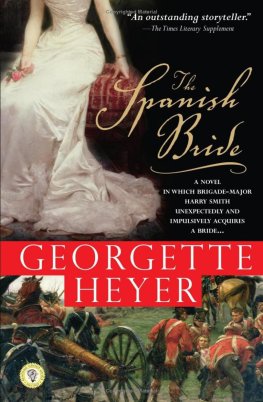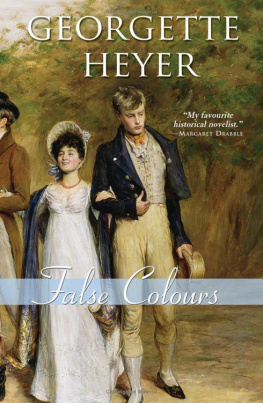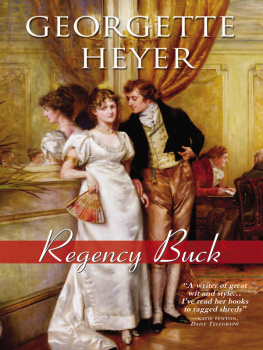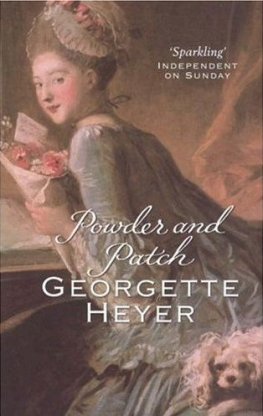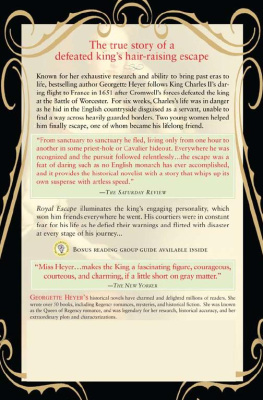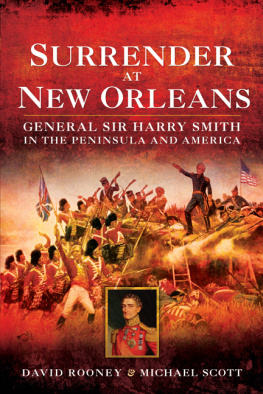Georgette Heyer - The Spanish Bride
Here you can read online Georgette Heyer - The Spanish Bride full text of the book (entire story) in english for free. Download pdf and epub, get meaning, cover and reviews about this ebook. year: 2011, genre: Romance novel. Description of the work, (preface) as well as reviews are available. Best literature library LitArk.com created for fans of good reading and offers a wide selection of genres:
Romance novel
Science fiction
Adventure
Detective
Science
History
Home and family
Prose
Art
Politics
Computer
Non-fiction
Religion
Business
Children
Humor
Choose a favorite category and find really read worthwhile books. Enjoy immersion in the world of imagination, feel the emotions of the characters or learn something new for yourself, make an fascinating discovery.
- Book:The Spanish Bride
- Author:
- Genre:
- Year:2011
- Rating:4 / 5
- Favourites:Add to favourites
- Your mark:
- 80
- 1
- 2
- 3
- 4
- 5
The Spanish Bride: summary, description and annotation
We offer to read an annotation, description, summary or preface (depends on what the author of the book "The Spanish Bride" wrote himself). If you haven't found the necessary information about the book — write in the comments, we will try to find it.
The Spanish Bride — read online for free the complete book (whole text) full work
Below is the text of the book, divided by pages. System saving the place of the last page read, allows you to conveniently read the book "The Spanish Bride" online for free, without having to search again every time where you left off. Put a bookmark, and you can go to the page where you finished reading at any time.
Font size:
Interval:
Bookmark:
Georgette Heyer
The Spanish Bride
The Spanish Bride
Georgette Heyer
1940
Authors Note
Since a complete list of the authorities for a book dealing with the Peninsular War would make tedious reading, I have published no bibliography to The Spanish Bride, preferring to add a note for those of my readers who may wish to know which were my main works of reference.
Obviously, the most important authority for Harrys and Juana Smiths story is Harry Smiths own Autobiography. Obviously again, it would have been impossible to have written a tale of the Peninsular War without studying Napiers work, and Sir Charles Omans monumental History of the Peninsular War. I must acknowledge, as well, my indebtedness to Sir Charles Omans smaller work, Wellingtons Army; and I should like to thank both Sir Charles Oman, and Colonel Jourdain, for their kindness in searching for an obscure reference on my behalf.
I have not, to my knowledge, left any of the Diarists of the Light Division unread. Of them all, I found Kincaid and George Simmons the most useful for my particular purpose; but the details of the rank-and-file of the 95th Rifles were culled largely from Edward Costellos Adventures of a Soldier. But Rifleman Harris was useful too; and so was Quartermaster Surtees, in spite of his unfortunate habit of covering all too many pages with moral reflections.
Outside the Light Division, Larpents Journals provided endless details. And there are grand bits to be found in Grattans Adventures with the Connaught Rangers; in Sir James McGrigors Autobiography; in Gleigs Subaltern; in Gomms Recollections of a Staff-officer; and in Tomkinsons Diary of a Cavalry Officer. There is a book of Peninsular Sketches, too, compiled by W. H. Maxwell; and all sorts of information to be gathered from the Lives of various commanders, not to mention the regimental histories. And last, but certainly not least, there are the Dispatches, and the Supplementary Dispatches, of Wellington himself.
Georgette Heyer
Chapter One. Badajos
There was a place on the right bank of the Guadiana where hares ran strong. It was near a large rabbit-warren, quite a celebrated spot, which the officers of the army besieging Badajos had soon discovered. Sport had been out of the question during the first part of the siege when the torrential rain had fallen day after day, flooding the river, sweeping away the pontoon-bridges that formed part of the communication-lines from Badajos to headquarters at Elvas, turning all the ground round the town into a clay swamp through which the blaspheming troops struggled from their sodden camp to the trenches. Having broken ground on St Patricks Day, the army, which boasted a large proportion of Irishmen in its ranks, was confident that this third siege of Badajos would be successful. But the drenching rain, which persisted for a week, threatened to upset all Lord Wellingtons plans. From the moment of opening the first parallel, the most appalling weather had set in. Trenches became flooded; the mud in the gabions ran off in a yellow slime; and men worked in water that rose to their waists. It was harder to bear than the firing from the walls of the town, for it was disheartening work, and good infantrymen hated it. They called it grave-digging, labour for sappers, not for crack troops. There was, unfortunately, a dearth of sappers in the army. Ah, may the divil fly away with old Hookey! Didnt we take Rodrigo, and is ut not the time for others to ingage on a thrifle of work? demanded Rifleman OBrien. On the 24th March the rain stopped, and fine weather set in. The digging of the parallels went on quickly, in spite of the difficulty of working in heavy, saturated clay, and in spite of the vicious fire from Badajos. The Portuguese gunners, bombarding the bastions of Santa Maria and La Trinidad, fell into the way of posting a man on the look-out to declare the nature of each missile that was fired from the walls. Bomba! he would shout, or Balla! and the gunners would duck till the shot had passed. Sometimes the look-out man would see a discharge from all arms, and, according to Johnny Kincaid, fling himself down, screaming Jesus, todos, todos!
With the better weather, thoughts turned to sport. A partridge or a hare made a welcome addition to any soup-kettle. It was Brigade-Major Harry Smiths boast that there was not an officers mess in the and brigade of the Light division which he did not keep supplied with hares. In infantry regiments, in the general way, it was only possible for Staff-officers, with a couple of good remounts, to indulge in hunting or coursing, nor was it by any means every Staff-officer who owned a string of greyhounds. But Brigade-Major Smith was sporting-mad, and wherever he went a stud of horses and a string of Spanish greyhounds went too. If he had a few hours off duty, he would come into camp from the trenches, shout for a bite of food, swallow it standing, and set off on a fresh horse, and with any friend who could be induced to forgo a much-needed rest for the sake of joining him in an arduous chase. But however heavy the going the sport was good, hares being plentiful, and Harrys greyhounds, despised by those who obstinately upheld the superior speed and intelligence of English hounds, generally successful.
The Brigade-Major was a wiry young man, rising twenty-five, with a dark, mobile countenance, a body hardened by seven years service in the 95th Rifles, a store of inexhaustible energy, and a degree of luck in escaping death that was almost uncanny. If he had not been such an efficient officer, he would have been damned as a harum-scarum youth, and had indeed often been sworn at for a madman by his friends, and his various Brigadiers.
His restless energy made his friends groan. Oh, to hell with you, Harry, cant you be still? complained Charlie Eeles, haled from his tent to the chase. Oh, very well, Ill come! Who goes with us? Stewart. Bustle about, man! I must be back by six oclock at latest. Grumbling, cursing, Lieutenant Eeles turned out, for although he had been on duty for six hours in the trenches, and was tired and cold, it was always much more amusing to go with Harry than to stay in camp. By the time he was in the saddle, Captain the Honourable James Stewart had joined them, mounted on a blood-mare and demanding to know what was keeping Harry.
The Light and 4th divisions being encamped on the southern side of Badajos, near the Albuera road, the three young men had not far to ride before crossing the Guadiana river. The weather, though dry, was dull, and the sky looked sullen. Badajos, crouching on rising ground in the middle of a grey plain, lay to their right, as they rode towards the river. A Castle, poised upon a hundred-foot rock, dominated the eastern side of the town, and overlooked the confluence of the Guadiana with the smaller Rivillas river. On this side of Badajos, Sir Thomas Pictons Fighting 3rd division was encamped, and the parallels had been first cut. The French, defending the town, had built up the bridge that crossed the Rivillas near the San Roque gate, south of the Castle, and had strengthened the two weakest bastions of the town-those of San Pedro and La Trinidad-by damming the Rivillas into a broad pool, guarded by the San Roque lunette. This inundation stretched from the bastion of San Pedro to La Trinidad, its overflow seeping into cunettes dug immediately below the walls of the town. An attempt to blow up the dam had failed, on the and April, and the inundation remained, blocking the approach from the first and second parallels, and covering all the ground from the walls of Badajos to the Seville road. Beyond the inundation, an outwork, known as the Picurina fort, had been carried by a storming-party from the 3rd division, under Major-General Kempt, on the 26th March. West of La Picurina, and due south of the town, a strong out-fort, the Pardeleras, was still in French hands; and on the right bank of the river, north of the town, the San Cristobal fort, standing on a hill that overlooked the Castle, and the old Roman bridge that spanned the Guadiana, towered over all. In previous sieges, the attacks had been directed against San Cristobal, and had failed; but in this chill spring of 1812, Lord Wellington, fresh from the conquest of Ciudad Rodrigo, had marched his troops south through Portalegre and Elvas, on the Portuguese border, to invest Badajos on the south and east sides. Everyone knew that the assault was to be made on the weaker bastions of Santa Maria and La Trinidad, for these, and the curtain between them, were being relentlessly bombarded; and everyone knew that time was a more than usually important factor in these operations. Marmont, his headquarters at Valladolid, might be contained by a covering force of Spaniards to the north; but there was news that Soult, with the French army of the South, had broken up from before Cadiz, and was moving to the relief of Badajos.
Font size:
Interval:
Bookmark:
Similar books «The Spanish Bride»
Look at similar books to The Spanish Bride. We have selected literature similar in name and meaning in the hope of providing readers with more options to find new, interesting, not yet read works.
Discussion, reviews of the book The Spanish Bride and just readers' own opinions. Leave your comments, write what you think about the work, its meaning or the main characters. Specify what exactly you liked and what you didn't like, and why you think so.

